Hardwood flooring is a considerable investment and many homeowners look for ways to preserve and protect the surface of the wood for as long as possible.
While there are many ways you need to adopt such as staining and finishing which are unanimously agreed upon, some measures and their importance is often debated by homeowners and professionals alike.
Such a measure is having underlayment beneath hardwood floors to provide them protection against all the factors coming from the subfloors.
Underlayment for hardwood flooring is optional but essential for protection. If boards have underlayment, you may not need more. Debates persist, yet underlayment plays a vital role in safeguarding and enhancing performance. Install for optimal floor protection.
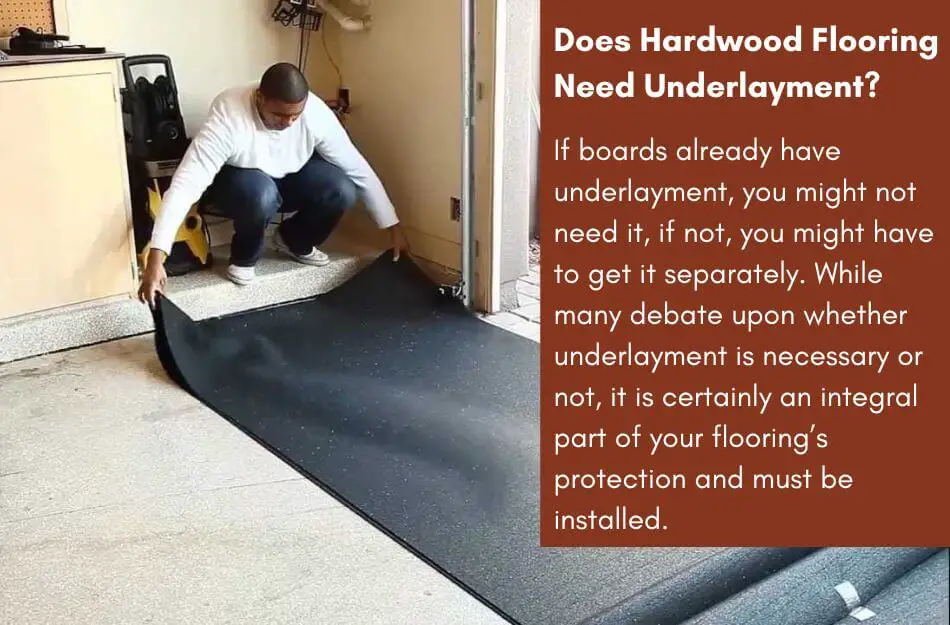
While there are scenarios where the planks are already equipped with underlayment from the time of manufacturing, you might need an additional layer.
This layer would be according to your preferred results that you want from the hardwood floors which you can install without any hesitation.
However, there are many benefits of hardwood floor underlayment apart from protection which are mentioned ahead.
Besides, choosing the right type of underlayment according to your floors is an integral procedure elaborated at the end so make sure you don’t miss out on any of it.
Table of Contents
- 1 What Is Hardwood Floor Underlayment?
- 2 Does Hardwood Flooring Need Underlayment?
- 3 Hardwood Floor Underlayment Options
- 4 Choosing The Right Underlayment For Your Hardwood Floors
- 5 Is It Necessary To Use An Underlay In Hardwood Flooring?
- 6 What Is The Recommended Underlayment For Hardwood Flooring?
- 7 Does Hardwood Go Directly To The Subfloor?
- 8 Conclusion
What Is Hardwood Floor Underlayment?
Underlayment refers to a layer of a shield between the hardwood boards and the subfloors.
There are various types of floorings in the market these days, and many of them now come with a factory-installed underlayment layer pre-attached to them.
This eliminates the requirement of installing an individual or separate layer under your floors.
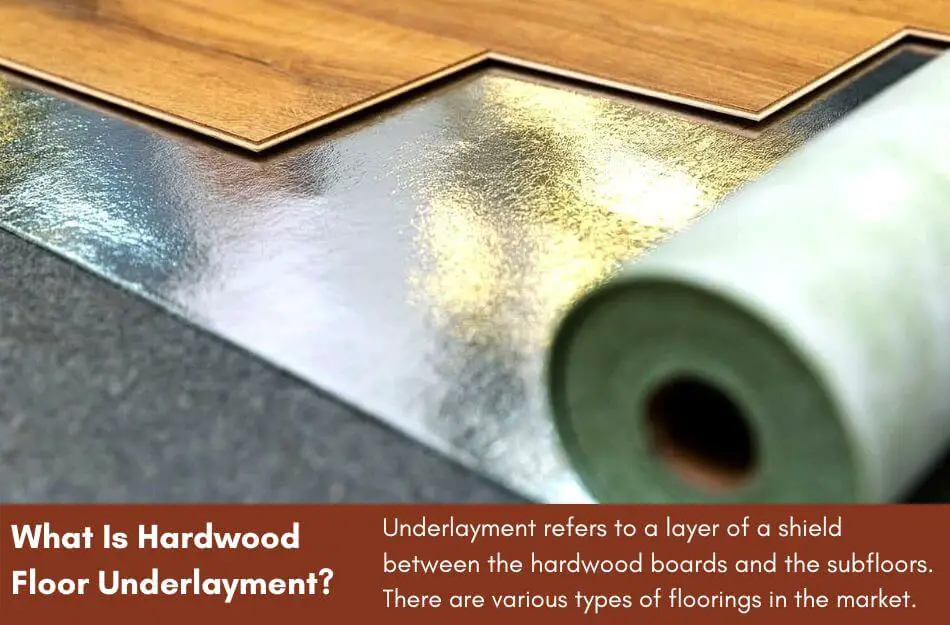
However, if the floors do not have a pre-attached layer, you would certainly need this as a barrier between your hardwood surface and the subflooring structure for the integrity and durability of your floors.
Although the benefits are listed later in the articles, let us discuss them briefly so you can better understand why underlayment layers are important and the reason behind their extensive use.
Various materials, such as rubber, cork, foam, or felt, are used for the underlayment layer. However, the main purpose is to protect the subflooring from any damage from the hardwood floor surface and vice versa.
This layer prevents both your structures from getting affected by the damage caused to one surface or side.
Consider this as the earth wire, which neutralizes the current and secures the entire circuit from getting short-circuited. Various types of materials used for the underlayment layer have different benefits.
Though all types of materials are effective, they have different perks over each other, so make sure you choose the right type of underlayment layer for your hardwood floors.
It will increase the durability and longevity of your hardwood floors and make them last a lot longer.
Does Hardwood Flooring Need Underlayment?
If your hardwood floors already have a pre-attached underlayment layer, you would not need to install another one externally to protect them from possible damage.
However, if your hardwood floors do not have such a layer installed from the factory, you must install it externally to ensure your hardwood floors and subflooring structure are well-protected and secure.
Moreover, there are various benefits of having an underlayment layer beneath your hardwood floors apart from the safety and protection features.
A very excellent feature provided by the underlayment layer is stability on the floors. Often, loose subflooring structures or improper installment of the hardwood planks can result in cracking floors.
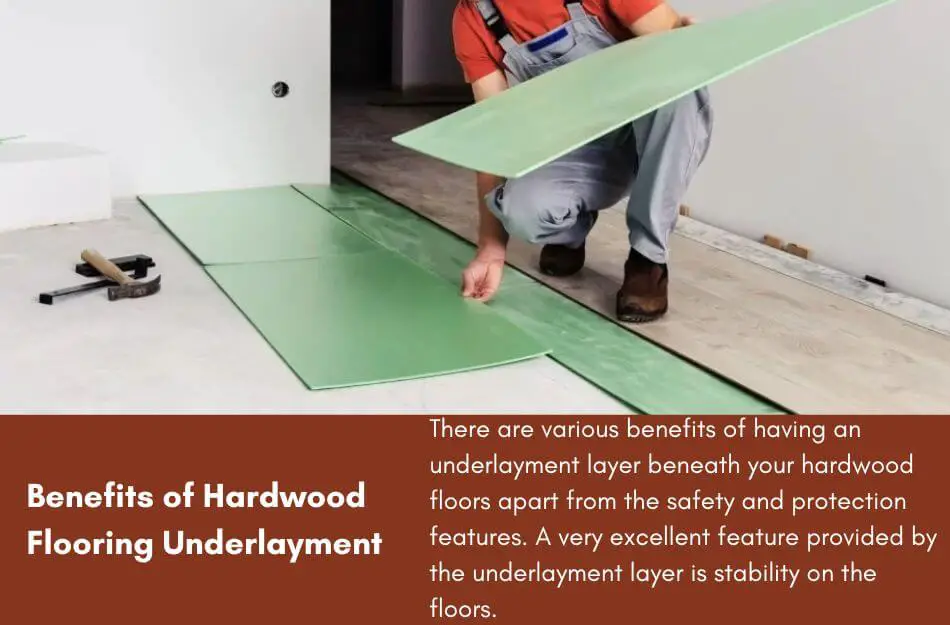
The floors make silly noises and move slightly when you step on them, which seems a nuisance.
While undoing the entire subfloor and the hardwood surface to reinstall properly would be too much of a task, you can easily install a hardwood underlayment layer to ensure that the structure is tight and does not have any extra space to allow such movements.
This minimizes the risks of buckling, lifting, tripping on the floors, and bounciness of floors, however, it also provides added strength as the layer absorbs much pressure previously tolerated by the hardwood boards and the subflooring structure only.
Moreover, it can also prevent your hardwood floors from warping and crowning due to the effective barrier it makes from the upper or layer surface of the entire structure.
Having an underlayment layer is very underrated, and many people fail to recognize its importance.
However, those who do will find that their floors are stronger and more durable and will surely see a much longer life of their floors after this simple measure.
There are many more benefits of hardwood floor underlayment layers, which are often ignored or overlooked by homeowners as well as flooring specialists.
But worry not, as we have compiled many of them so you can better comprehend why installing an underlayment layer beneath your hardwood floors is best.
Moisture Barrier
It has been emphasized in many places and numerous times before that water and moisture are the greatest enemies of hardwood floors.
Be it during cleaning the floors, in damp environments, in case of leakages, or during the season of rain, flooring specialists always focus on the fact that you should do everything you can to protect your hardwood floors from the moisture content in the surroundings.
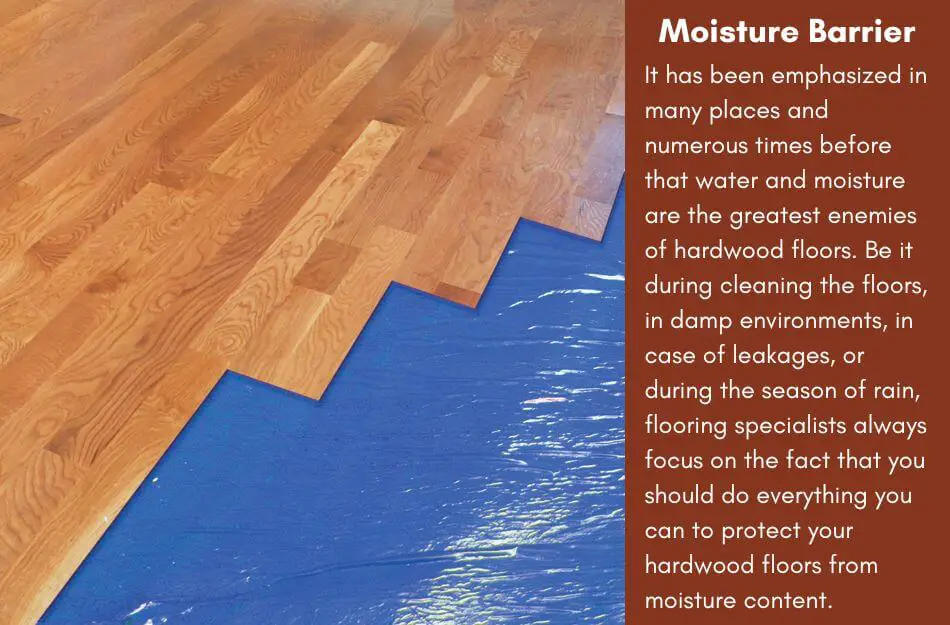
Being exposed to high water or moisture content can cause the hardwood planks to warp, crack, crown, lift rot, chip, and weaken over time.
However, while many homeowners are satisfied with the fact that they perform efficient cleaning of floors and do not let excess moisture come in contact with the wooden surface, they also witness extreme damage through moisture.
As it is ignored on many occasions and homeowners tend not to pay much attention to it, moisture from underneath the floor surface is the biggest threat to the safety and health of your hardwood floors.
Whether your hardwood floors are installed directly on the soil, as is the case with vintage flooring methods, or it is installed on a concrete slab following the contemporary methods, you are not safe from moisture in any case.
The ground holds the greatest amount of moisture; over time, this moisture travels upwards and to your subflooring structure.
If your hardwood floors are installed on concrete, it can take some time before the moisture seeps up to the subfloors.
However, in cases of direct installment on the ground, you can start experiencing this issue within a few months. The moisture can travel upwards and weaken your subfloors.
Furthermore, this does not stop here, as the moisture then travels to your hardwood boards and destroys them from within.
However, having an underlayment layer can prevent this from happening, as it is an impermeable barrier that does not allow anything to pass through from either side.
Hence, it protects your floorboards and prevents them from suffering from the same fate as your subfloors.
Therefore, it is always preferred to save your hardwood floors from getting ruined by moisture and install an underlayment layer for optimum protection.
Sound Reduction
Many homeowners who have hardwood floors installed often face the issue that hardwood floors are too noisy. However, this problem can be solved using an underlayment lawyer.
If you live on the first or second floor and your downstairs neighbors are often disturbed by the additional voices and stomping from above, installing this layer is the most optimum solution for you.
Due to their impermeable surface, they also stop sound waves from passing through and act as sound barriers between you and your neighbors.
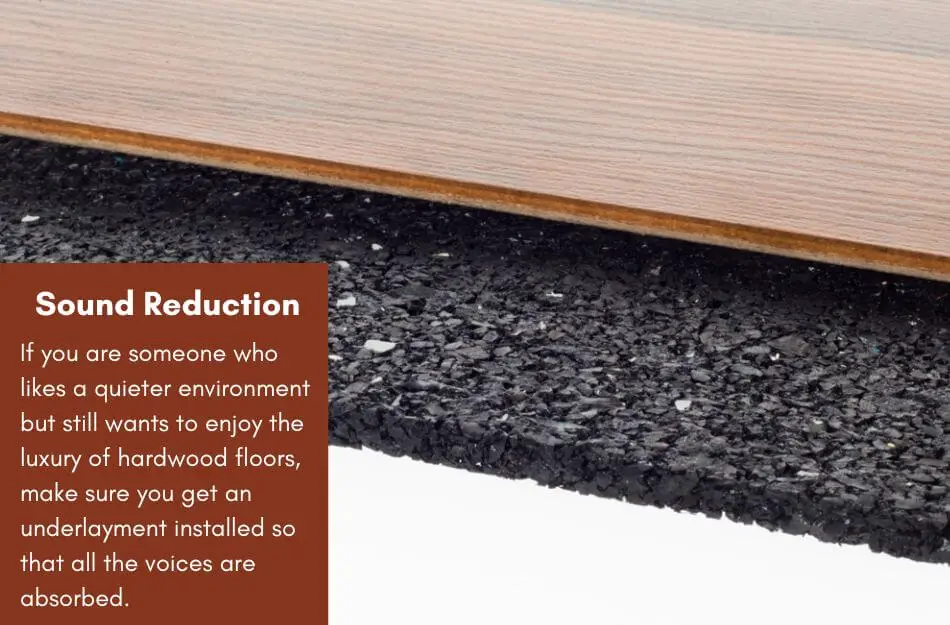
In addition, this works on the level below and will make the room or the house much quieter as a significant factor will reduce the echo.
Generally, hardwood floors are installed directly in the foundation, which leaves a small gap creating an air pocket. This causes echo whenever there is a movement on top of the floors or when voices pass through to that point.
However, this is greatly reduced after an underlayment layer, and you can enjoy conversations with your loved ones and movements on the floors without worrying about the voice being echoed to the room downstairs or in the house generally.
Hence, if you are someone who likes a quieter environment but still wants to enjoy the luxury of hardwood floors, make sure you get an underlayment installed so that all the voices are absorbed and muffled rather than being amplified.
Insulation
Hardwood floors are often criticized for not being suitable for colder environments as they are very cold and do not retain heat very efficiently.
This makes the overall temperatures in the house much lower and makes it almost impossible to walk barefoot on the floors.
Moreover, having hardwood floors in winter means you must be ready for a cold floor in your house.
While many homeowners sought the support of carpets and rugs in this situation, an underlayment installation can be your permanent solution to this problem.
As hardwood floors are referred to as being chilly in winter, underlayment can solve this problem once and for all.
It allows the floors to retain the heat generated from the heaters, movement, and bodily heat, which is transferred upon contact with the floors.
This means that while your hardwood floors used to absorb the coldness from the atmosphere previously and retained it, they will now provide an additional source of heat which will be retained in the floors.
One of the major logical reasons behind this is that due to the absence of a layer between the floors and the subfloors, the heat passes on and gets absorbed by the subfloors or the ground.
Having an underlayment can prevent this from happening, as it traps the heat above the surface and denies access to the subfloors. This makes the floors warmer over time and solves the issue of heat retention.
Therefore, having an underlayment beneath your hardwood floors is the perfect source of insulation in winter, and as the floors are already cold in all environments, it would also maintain normal temperatures in other seasons.
This makes the floors a lot more comfortable and allows you to walk barefoot without the risk of catching a cold due to the chilly surface.
Besides, this insulation also makes it safe for the children to play on the floors as they won’t be bothered by the coldness of the floors anymore.
Cushioning
If your hardwood floors are squeaky or you don’t find the comfort and softness you expect from your floors, an underlayment layer can fix this problem for you.
It is important to note that the hardwood boards and the subflooring structure are all wood and fastening materials, and no soft or cushioning material is used.
This is the reason why your hardwood floors feel so rigid and hard when you tread across them. Many homeowners install carpets to achieve this cushioning effect, but that is an added expense and not a permanent solution.
Hardwood planks bend upon impact, and if there is nothing to absorb that face, they will rebound back to their original form, causing the rigid structure.
However, installing an underlayment will prevent this from happening as it will offer a cushioning surface to the planks themselves.
Hence, when you step on the planks, they will press onto the underlayment, absorbing the pressure and allowing smooth recoil, making the boards much softer for you.
Although underlayments are very thin and one would not expect such results, they allow ample room for the hardwood floors to expand or contract in all directions allowing for a better and softer walking experience.
Besides, this will help eliminate the squeaky noises and increase the durability and longevity of your wooden flooring.
Stability
If you have allowed acclimation to the wood beforehand, you might not face this problem to a high level of intensity, but it still does exist in hardwood floors.
As the wood expands and contacts, it becomes squeaky and often presses upon the boards in the vicinity, creating too many gaps. This can result in an unstable platform which shakes when you move on your hardwood floors.
Another common reason for this to happen is loose subfloors or improper installation of the planks by your flooring specialists.
Moreover, such a situation can also be experienced if the nails in your boards have loosened or are starting to come off.
However, all of these problems can be solved with an underlayment layer. Once you get it installed beneath your hardwood floors, you won’t have to worry about these problems again.
An underlayment provides stability to the hardwood boards, allowing them the optimum space to expand and contract while keeping them in place so that they don’t sway around or shake when someone walks on them.
Besides, this can also help keep the hardwood floors safe from dangers such as buckling, warping, or pulling at the seams. Regardless of the type of wood, most floors are installed as floating floors which is the most common reason behind this problem.
To simplify it, the flooring is not fixed into the subfloor structure and is simply placed on top and fastened.
This results in the instability you experience; however, this will not be the case once an underlayment is installed, as it provides a suitable structure and support platform underneath the floors, which offers strength and stability from underneath.
Many flooring specialists go along with the floating floors approach because it is quite popular and easy compared to proper installation.
However, this can cause damage to your hardwood floors, and having an underlayment layer is one of the most useful ways to prevent this.
Hardwood Floor Underlayment Options
Now that we have established the facts regarding why you need underlayment for your hardwood floors let us move on to the options you have when installing underlayment under your hardwood floors.
Although many materials can be used as an underlayment, there are mainly 4 types of underlayment which professionals prefer.
All of these work efficiently, and each has its perks and benefits. Hence, the choice is yours to choose the best option which is the most suitable according to your preferences and requirements.
Besides, it is also important to note the hardwood you have in your home to determine which underlayment material would work the best with the specific type of wood.
Make sure to do all the preliminary research beforehand to understand better what will suit you best and which materials are the most appropriate for your situation.
An important tip is to note the sound and density ratings of your underlayment material so you can understand how much protection against sound and other factors you will achieve.
Below are some of the most common and renowned types of underlayment materials.
Felt
You might’ve heard felt pads are a safe way to place furniture on your hardwood floors without damaging the finish or the wood.
Similarly, felt is a suitable underlayment material and is quite popular among other materials. With felt, you get the basic resistance against sound and moisture, so you don’t have to worry about the efficiency of the material and the protection of your hardwood floors.

However, if you want added benefits such as insulation and cushioning effects, felt does not disappoint you. You can easily opt for a heavier layer of black felt with a higher density.
Not only will it provide you with the desired insulation to keep your hardwood floors warm, but it will also ensure that the floors are soft and comfortable to walk on.
Moreover, this will also add to the strength and stability of the floors, as the hardwood will not be under as much pressure as in usual circumstances before the underlayment layer was installed.
This option provides basic moisture resistance and sound absorption. In addition, you can choose the density of felt so that you are not getting something extra than what you wanted from your floors.
Another noteworthy feature is that felt is extremely eco-friendly as it is manufactured from recycled materials. Hence, if you are someone who worries about the environment, you can rest assured that the product you will buy is friendly to the environment.
Moreover, felt is a much simpler substance when it comes to protection. But this simplicity does not compromise the efficiency of the material.
Although you are getting many benefits from high-density felt in many areas, you might not get the desired level of sound absorption with this material.
Foam
Foam is yet another suitable and efficient underlayment material which offers you durability and ease of installation at the same time.
Although it provides features similar to felt, it differs in many places. Notably, the foam used in underlayment differs greatly from the foam used in cushions or mattresses.
One of the greatest benefits of foam as your underlayment material is its cushioning effect on your floors.
We are all aware of the softness provided by foam, and the same attributes are seen in your hardwood floors when the foam is used in the underlayment.
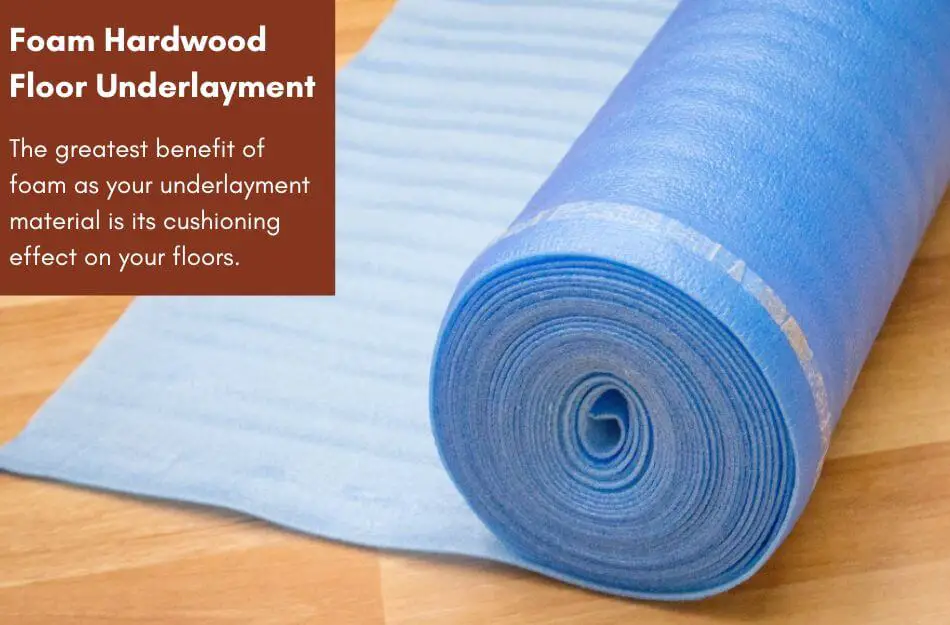
Apart from this, foam prevents the squeakiness of the floors and offers you a stable platform to tread upon. In addition, foam underlayment also provides an optimum level of insulation.
Due to its slightly porous surface, it traps hot air and retains heat under the hardwood floors to prevent them from getting cold in winter.
Besides, as wood acclimates according to weather conditions, foam allows for optimum flexibility without compromising the floors’ stability.
A logical reason behind this is that foam reduces friction between the hardwood boards and the subflooring, which allows for smoother expansion or contraction.
This saves the boards from the unnecessary grit they go through, causing decay and weariness on the underside of the planks.
Furthermore, if you are concerned about the sounds and echo in your house, you must choose foam as it is supposedly the best sound absorber among all underlayment materials.
This prevents hollow noises from under the floors and limits the amount of echo within the room, making the ambiance much quieter and more peaceful.
However, foam is not the best moisture barrier you can have in your structure. Although some types of foam underlayments come with a built-in vapor barrier which protects the wood against any damage caused by moisture, it is still not as good as other materials.
You can still install it in areas with low moisture content, but you must reconsider your decision if you want to get it installed in your kitchen, bathroom, or any other place with high moisture content.
Cork
For those environmental activists out there who are concerned about sound pollution, cork is the best choice for you if you want an eco-friendly underlayment material which absorbs sound well.
Although this is less popular than the other types of materials, cork is extremely effective and has many noticeable features for protection of all sorts for your hardwood floors.

One of the greatest attributes of cork is that it is a natural and renewable source, so you don’t have to worry about straining nature for your benefit.
Besides, it is a very common underlayment material for apartments, flats, or rooms built on second stories, mainly due to its excellent sound-absorbing qualities.
While you might be appreciating cork’s good sound absorption, let us shine a light on its stability on hardwood floors.
Cork is very firm and flexible, and one would not think that it can provide the level of stability to hardwood floors that it does.
Many homeowners get extremely anxious when they realize that the professional service they hired has ruined their subflooring structure which can lead to many dangers to the hardwood floors.
However, instead of stripping off everything and redoing the process all over again, you can simply install cork underlayment to eliminate all potential problems.
It provides firm support to the hardwood floors and eliminates unnecessary gaps to keep the structure as tight as possible.
Similar to foam, it reduces the friction between the floors themselves and the subflooring to allow for optimum expansion and contraction.
Apart from these, cork is also an excellent insulator that allows for the heat and the boards to be kept warm.
It keeps the temperature regulated on the floors and the entire house. Last but not least, being a natural substance, cork has some properties which all other materials lack.
Cork has antimicrobial properties that prevent and limit bacteria growth in your hardwood floors. Moisture often causes molds and mildew to form in the planks or subfloor structure.
However, cork prevents this from happening and resits the growth of existing molds and bacteria.
Besides, it is an excellent moisture barrier, and if you pair these two properties together, you will have the most comprehensive layer of protection beneath your expensive flooring.
Rubber
If you are looking for a much simpler material which is very easy to install yet provides an optimum amount of protection, you must go for rubber.
Though it might sound weird, rubber is an excellent underlayment material as it has all the qualities you might be looking for.
The flexibility and pliability of the substance allow for stable wooden planks along with a reasonable amount of cushioning to make the floors much more comfortable for you and your children.
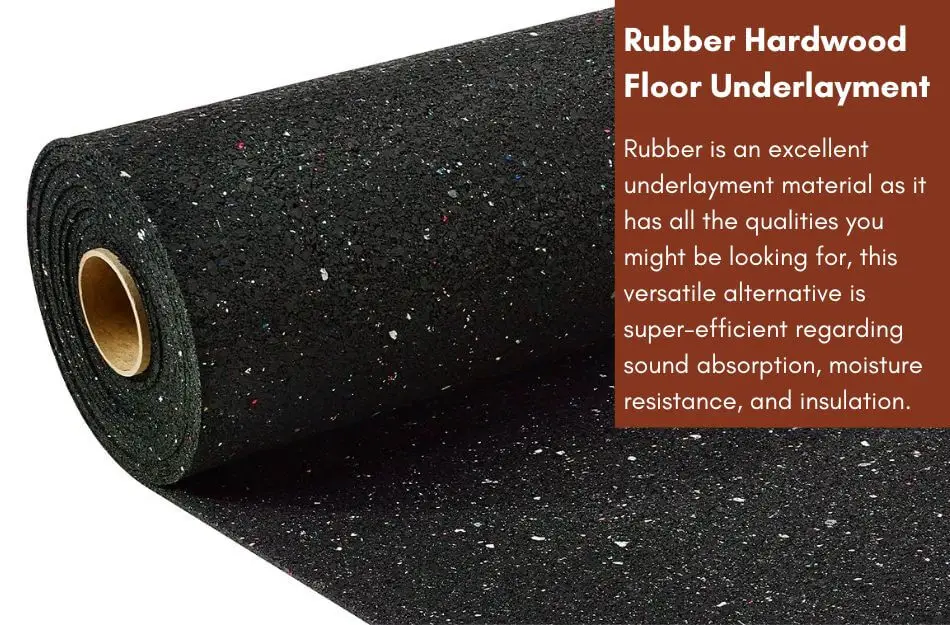
Besides, this versatile alternative is super-efficient regarding sound absorption, moisture resistance, and insulation.
The resilience of this material is exemplary and provides an immense level of protection against water and moisture. The durability of rubbers can be verified by the fact that vehicle tyres are also made from rubber.
As it is naturally waterproof, it does not allow moisture to seep inside your wooden surfaces and even becomes a deterrent to mold or mildew growth.
Rubber underlayment is a suitable option if you are worried about the hollow sounds and echoes from the floors.
Many flooring specialists consider it over-priced, but it is worth the money compared to the ease of installation and the perfect attributes in all scenarios.
Although it is not very popular, it is one of the best insulators and provides all the features you might want in an effective underlayment layer.
Hence, it is best to consider rubber when deciding the best underlayment material for your hardwood floors as they are durable, resistant to all factors that might concern a homeowner, and come in various thicknesses so you can get the customized effect on your hardwood floors.
Choosing The Right Underlayment For Your Hardwood Floors
While many homeowners tend to choose solely based on the characteristics of the layer material, there are better ways to do so.
There are some other factors you must look for when choosing the best underlayment. The first factor to remember is the type of wood used in your floorings.
Identifying the type of wood and acting accordingly is an integral part of the process which many people skip.
A general rule to remember is that softer woods such as black walnut, white oak, or red oak will always need extra support, while harder types such as hickory or maple require more insulation and flexibility than support.
Hence if the wood in your floorings falls into the softer categories, options such as cork or rubber underlayments are the most appropriate for your situation.
On the other hand, if they fall into harder wood types, it is better to focus more on the other types, such as foam or rubber.
The next factor to remember is the room in which the underlayment needs to be installed. The amount of traffic, moisture level, and weight on the surface are the factors which shall compel your decision for the best type of underlayment for the floors.
Moreover, if the room is situated upstairs, it is noteworthy that you must go for solutions with better sound absorption as it will greatly benefit you in the long term, especially if you live in an apartment building.
Moreover, focusing on insulation can save you money on electricity bills if you live in a colder environment.
Is It Necessary To Use An Underlay In Hardwood Flooring?
It is not necessary to use an underlayment for your hardwood flooring but it is always recommended due to the added benefits it provides.
You might not want to get an underlying layer if your planks are already equipped with it or if you think sealing them is enough.
However, the additional perks make it hard for any homeowner to not get them installed. These perks are:
- Stability of floors.
- Cushioning effect.
- Water/Moisture barrier.
- Sound barrier.
What Is The Recommended Underlayment For Hardwood Flooring?
There are mainly 4 types of underlayment materials and the right one will depend upon the type of wood used in your hardwood floors.
A general rule to remember is that softer woods such as black walnut, white oak, or red oak will always need extra support, while harder types such as hickory or maple require more insulation and flexibility than support.
Does Hardwood Go Directly To The Subfloor?
Subfloor materials such as vinyl, carpet, concrete, or ceramics are not strong and durable enough to hold the hardwood floors.
Hence, it is best to remove them before you get your hardwood floors installed. However, if you have a concrete base or if the wood is engineered hardwood, it can go on almost all surfaces and subfloors.
Conclusion
Hardwood floors most certainly need an underlayment to protect them from the dangers lurking from the subfloor.
While many people kept believing for a long time that underlayment is only effective against moisture and water, the other benefits which were mentioned earlier are also now proven as time has passed.
Hence, even if you are not concerned with protection and safety issues, you should still get an underlayment for your hardwood floors to get the added benefits that come with it.
Therefore, if you also have hardwood floors in the house and you have not been paying attention to an underlayment installation, it is high time to do so!

As a co-creator of FlooringFlow.com, Emma Sophia comes on board to answer all your questions related to any flooring problems. Together with John Henry, she’s gained extensive experience in fixing many flooring problems in their own house as well as in friends and family’s. Now, she wants to share her knowledge that she gained during floor remodeling, restoring, and DIY projects.

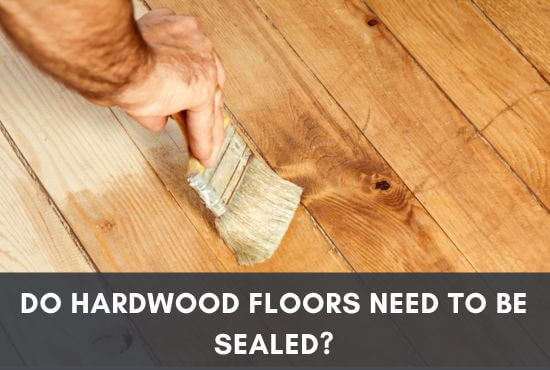
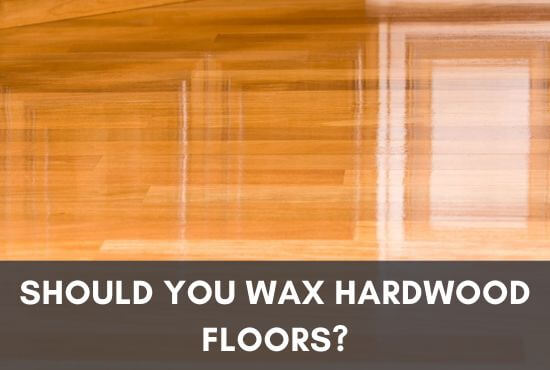
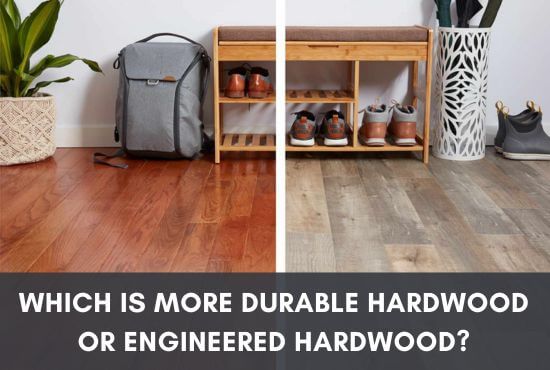
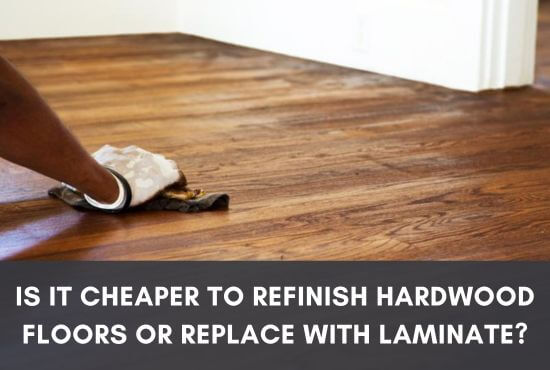
![70 Bedroom Color Schemes: [year] Home Bedroom Refresh 70 Bedroom Color Schemes: [year] Home Bedroom Refresh](https://flooringflow.com/wp-content/uploads/2024/07/25-Cool-4th-of-July-Decorations-for-Outdoor-Patio-to-Celebrate-in-Style-16.jpg)
